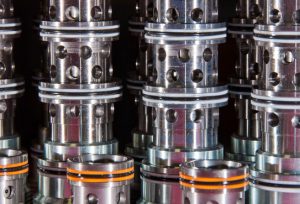
Hydraulic cylinders are commonly found in industrial machines. Consisting of an actuator, it uses hydrostatic energy to generate force. Hydraulic cylinders essentially use fluid to create a pull or push force. Because they contain fluid, however, they require the use of seals. There are hydraulic seals found in most hydraulic cylinders. What are hydraulic seals exactly?
Overview of Hydraulic Seals
Hydraulic seals are gasket-like rings that are designed to seal areas between the components in a hydraulic cylinder. Hydraulic cylinders contain many different components, some of which are exposed to the fluid. To prevent fluid from leaking around these components, hydraulic seals are used. Hydraulic seals are designed to fit the components in a hydraulic cylinder while creating a leak-proof seal around them.
Hydraulic seals are essentially o-rings. However, they feature a groove within the lip that allows them to fit the components with which they are used. The groove will slide over the component to create a leak-proof seal. Even when the hydraulic cylinder’s piston moves and its fluid pressurizes, the component won’t leak. The hydraulic seal will keep the fluid within the appropriate container so that it doesn’t leak around the component.
Static vs Dynamic Hydraulic Seals
Hydraulic seals can be categorized as either static or dynamic, depending on their intended application. Static hydraulic seals are used in applications where the component with which it’s used doesn’t move. They are still exposed to pressure, but static hydraulic seals aren’t exposed to movement.
Dynamic hydraulic seals, on the other hand, are exposed to movement. Rod seals are a common type of dynamic hydraulic seal. Hydraulic cylinders have a piston rod, which moves during operation. Rod seals are designed to seal these piston rods. They are considered a type of dynamic seal because piston rods move. Regardless, both static and dynamic hydraulic seals are used in hydraulic cylinders. The difference is that static seals remain stationary, whereas dynamic seals are exposed to motion.
Hydraulic Seal Materials
You can find hydraulic seals available in several materials. Rubber is a common material used for hydraulic seals. Rubber hydraulic seals are elastic, resistant to cracking and long-lasting. There are also polyurethane hydraulic seals. Polyurethane hydraulic seals feature many of the same qualities as those made of rubber, but they are typically stronger and better protected against wear. While not as common as rubber or polyurethane, some hydraulic seals are made of polytetrafluoroethylene (PTFE). PTFE is a synthetic material that’s flexible, strong and resistant to extreme temperatures.
